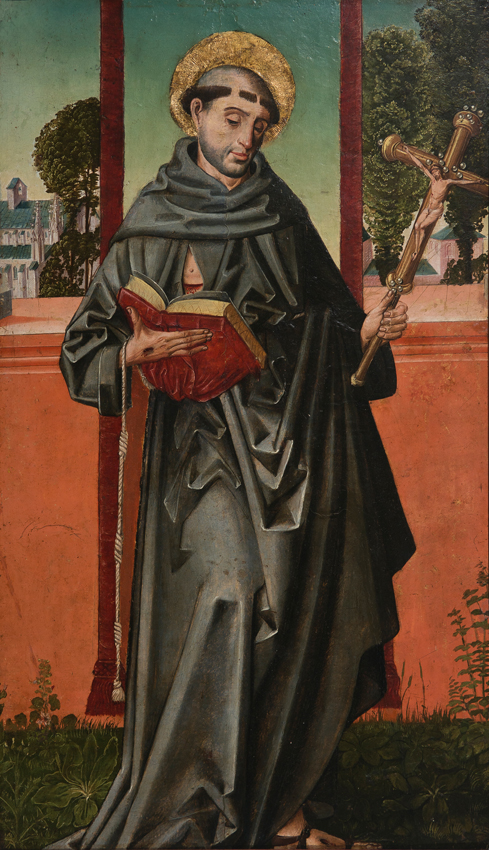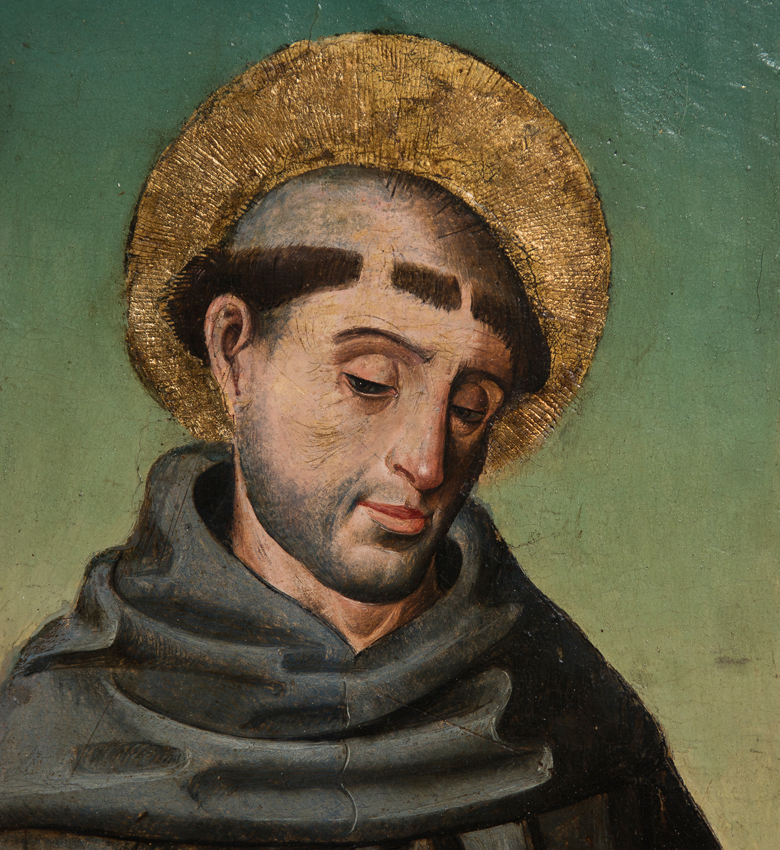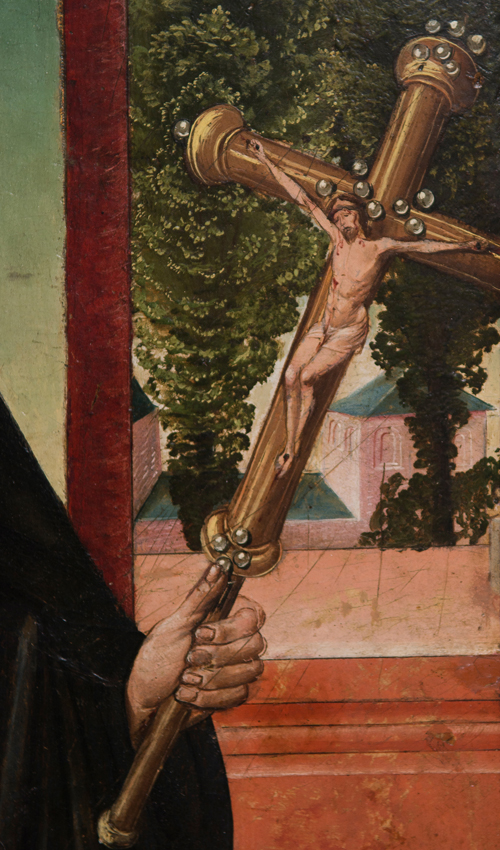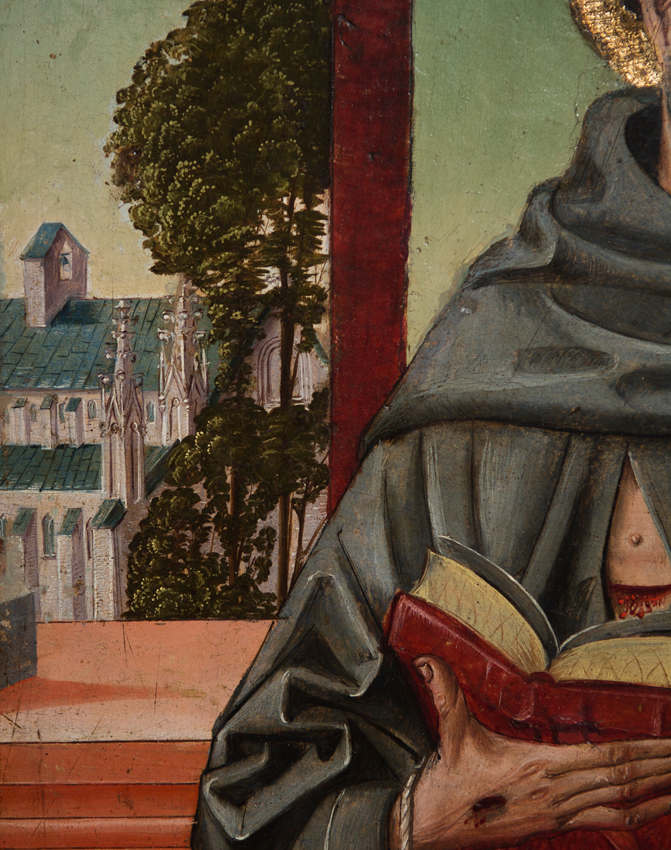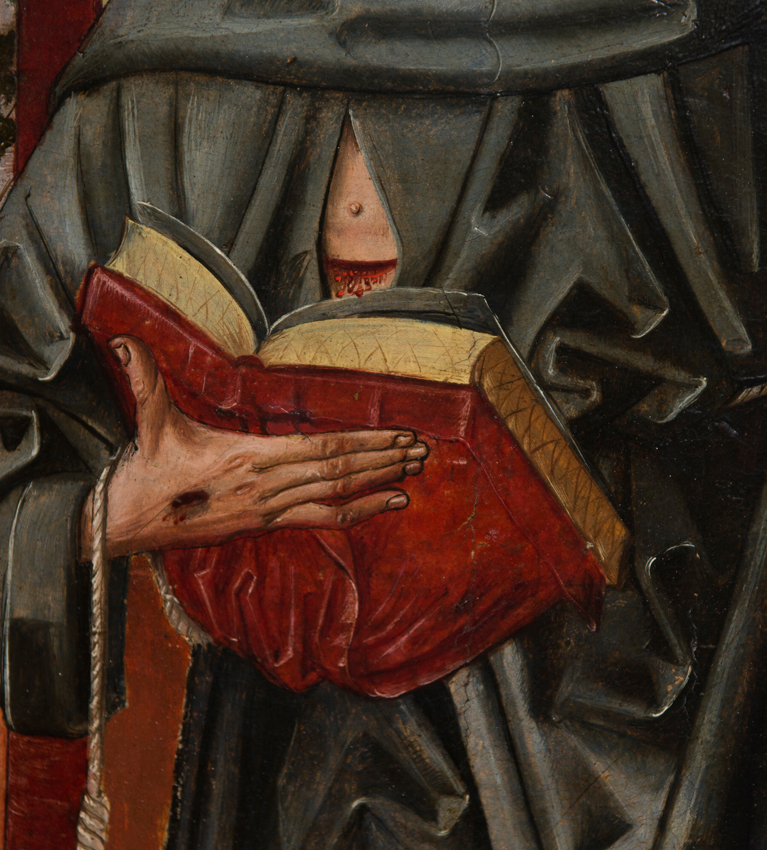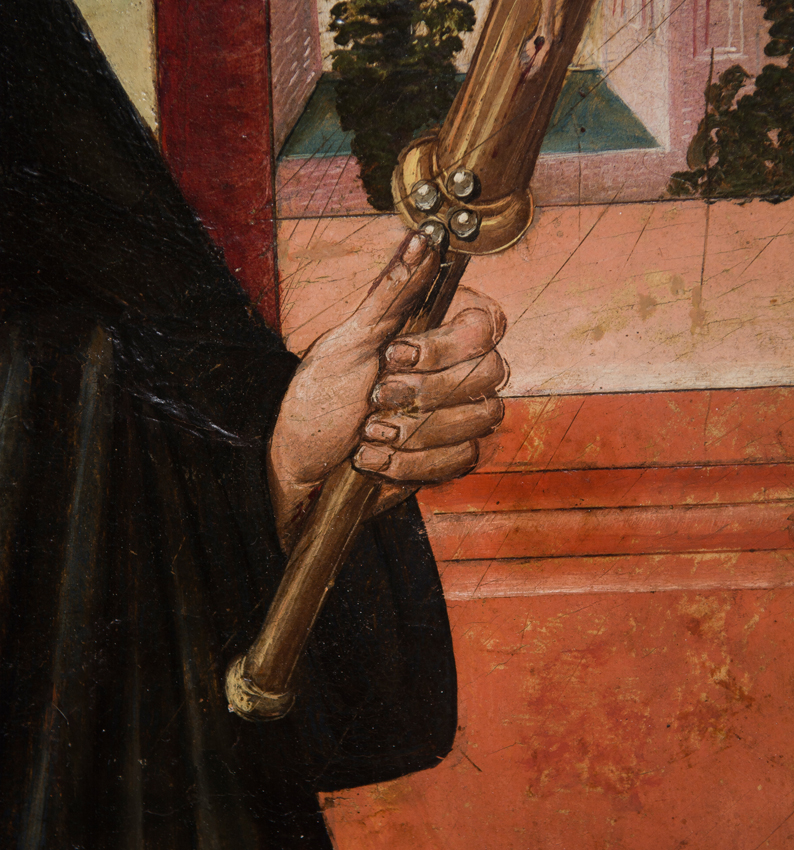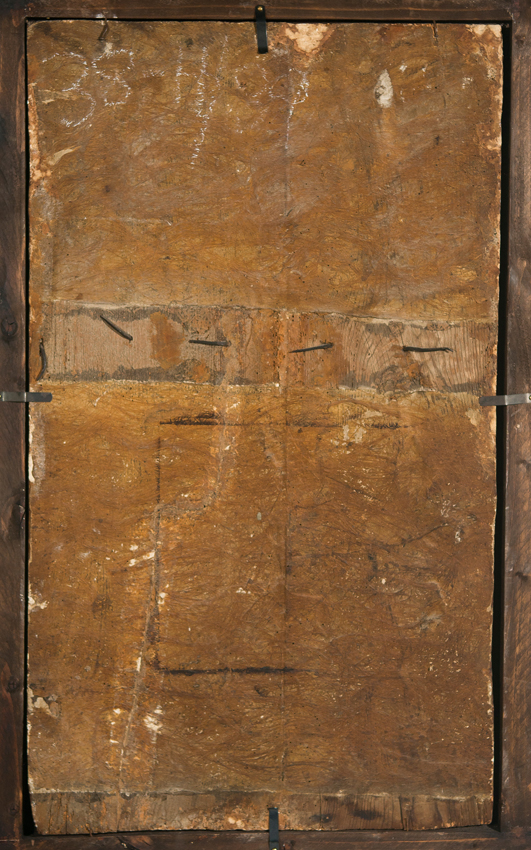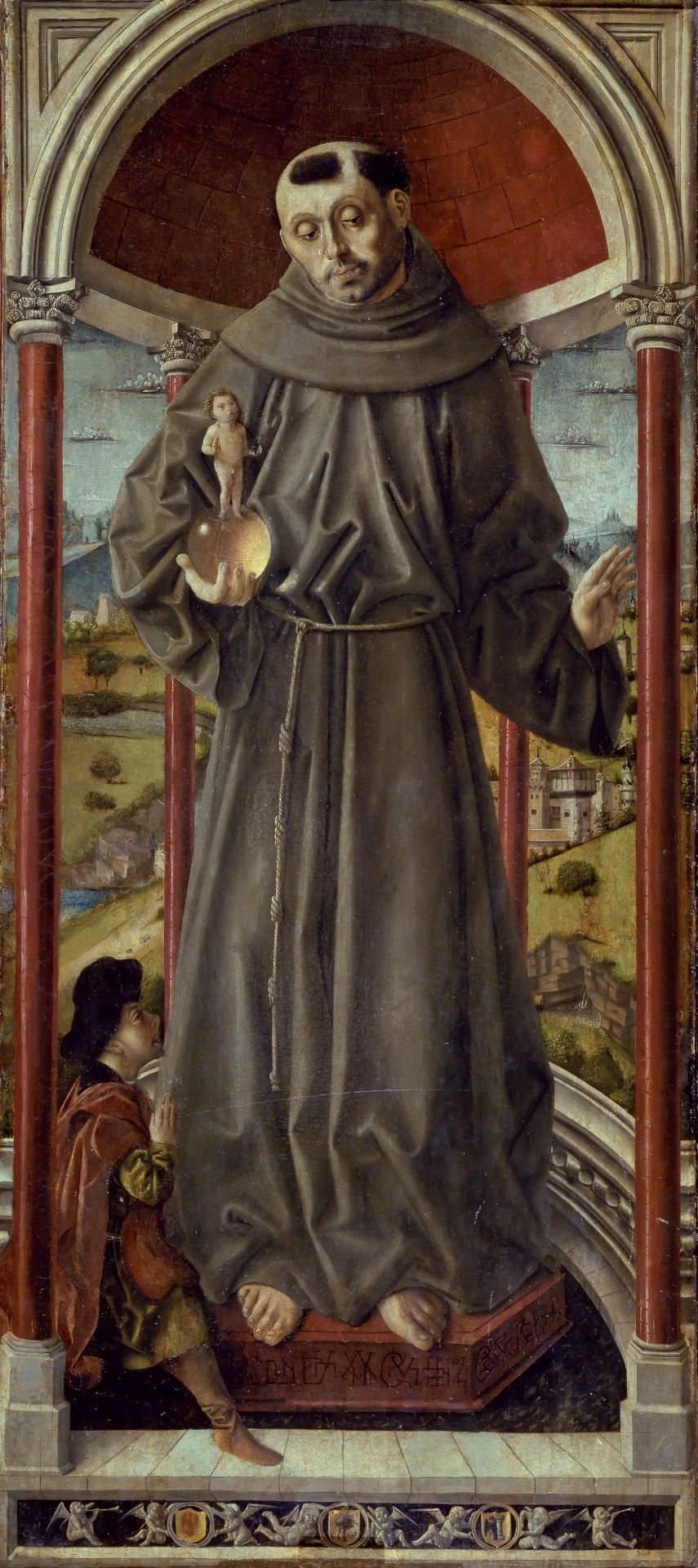5
Circle of the Master of don Alvaro de Luna, also known as Master of los Luna (Castilian painter, doc
In Millésime 24
Circle of the Master of don Alvaro de Luna, also known as Master of los Luna (Castilian painter, documented from 1483 -1504).
"Saint Francis of Assisi"
Oil and gold on panel.
84 x 49 cm.
Beautiful and elaborate depiction on panel of Saint Francis of Assisi holding the book of the Rules and the Cross, the symbol of San Damiano that made him change his life and dedicate himself to the church until his death.
The Master of Don Álvaro de Luna was a Castilian painter from the second half of the 15th century, active in Toledo and Guadalajara, and the surrounding areas. He worked in the service of the Mendoza family.
This painting is comparable to the Saint Anthony of Padua painted around 1500, currently kept in the Prado Museum (inv. P002574), and is attributed to the Master of Don Álvaro de Luna by Matías Díaz Padrón and Inmaculada Alonso Blázquez, thus modifying Sánchez Cantón's attribution to the painter Pedro Delgado that had existed since the 1940s . Post also mentions the panel in 1947, "attributing it to this master, [Delgado], although with some reservation." Later, José Camón Aznar maintained the thesis, still attributing the authorship to Pedro Delgado.
In the panel, we see the great influence of the Saint Anthony of Padua that is in the Prado. In both saints, we find a similar physiognomy, identical treatment of the folds in the habits called "tin foil folds." It shares, as we will see, characteristics defined by Díaz Padrón and Alonso Blázquez: 'The saint determines the axis of the composition, clad in the sacred solemnity that the piety of his time has conferred upon him. He is the protagonist and the centre of worship... The attribution to the Master of Don Álvaro de Luna can be confirmed through the comparative study of this painter's known artworks, which are plentiful enough to provide valuable evidence. The saint's face with prominent features due to backlight effects, deep shadows, round and sunken eyes, are common traits in the panels at the Prado Museum, the altarpiece of the Luna Chapel in Toledo, and many others."
Regarding the archaic character of the painting, which even uses gold for the halo, we see that it is also a characteristic feature of the painting of the Master of Don Álvaro de Luna, and as Díaz Padrón and Alonso Blázquez continue: 'Stylistically, the painter of the panel is an archaic painter for his time, as in some compositions, he approaches the schemes of Flemish masters from the mid-century. In others, however, there are references to an incipient Renaissance. The brocades and the meticulousness of detail in the landscapes are also traces of a Gothic style that asserts itself as the most persistent value in the master's work. The type of folds with straight, parallel forms and the plasticity of the modelling are within the sentiment of Castilian Hispanic-Flemish art, like the strong and toasted colours and the mystical breath.'
For all these reasons, in our opinion, this wonderful panel should be geographically attributed to Castile, specifically to the Toledo area, to the Circle of the Master of Don Álvaro de Luna, circa 1500
The saint displays the stigmata he received on Mount Alverna in his side, hands, and feet.
The painting has soft and expressive strokes. There is latent realism in all elements, the landscape, the botany (trees and the grass he stands on), the garments with "tin-plate" folds that give his figure the appearance of a freshly sculpted statue, the perspective and the virtuosity in the brushstrokes of the crucifix he holds as well as its beads...
The composition is in the shape of a cross: the vertical axis of the cross centres on the Holy Founder of the Order of Minims; on the vertical are two windows that open to two essential places for the Franciscans: on the left, the Basilica of Santa Maria degli Angeli, a basilica built between 1569 and 1679 that enclosed a small 9th-century church, the Porziuncola, the holiest place for the Franciscans, where young Francis of Assisi found his vocation and renounced the world to live in poverty amongst the poor and began the Franciscan movement.
On the right, and just visible amongst some trees (it was in ruins when the Saint arrived), is San Damiano, the first monastery of the Order of Saint Clare, where Saint Clare built her community, and the place where the encounter between Saint Francis and Christ on the Cross took place.
Bibliographic reference:
- Matías Díaz Padrón, Matías y Alonso Blázquez, Inmaculada. (1987) “Una tabla anónima de San Antonio de Padua, restituida al Maestro de Don Álvaro de Luna, en el Museo del Prado”. Boletín de l Museo del prado. Tomo 8, pág.5.
- Camón Aznar, José. (1983). "Summa Artis, Historia general del arte. La pintura española del Siglo XVI" Tomo 24, página 232. Espasa Calpe.
- https://www.museodelprado.es/coleccion/obra-de-arte/san-antonio-de-padua/743226e3-f14d-4a77-a49c-63f261ea1297
Circle of the Master of don Alvaro de Luna, also known as Master of los Luna (Castilian painter, documented from 1483 -1504).
"Saint Francis of Assisi"
Oil and gold on panel.
84 x 49 cm.
Beautiful and elaborate depiction on panel of Saint Francis of Assisi holding the book of the Rules and the Cross, the symbol of San Damiano that made him change his life and dedicate himself to the church until his death.
The Master of Don Álvaro de Luna was a Castilian painter from the second half of the 15th century, active in Toledo and Guadalajara, and the surrounding areas. He worked in the service of the Mendoza family.
This painting is comparable to the Saint Anthony of Padua painted around 1500, currently kept in the Prado Museum (inv. P002574), and is attributed to the Master of Don Álvaro de Luna by Matías Díaz Padrón and Inmaculada Alonso Blázquez, thus modifying Sánchez Cantón's attribution to the painter Pedro Delgado that had existed since the 1940s . Post also mentions the panel in 1947, "attributing it to this master, [Delgado], although with some reservation." Later, José Camón Aznar maintained the thesis, still attributing the authorship to Pedro Delgado.
In the panel, we see the great influence of the Saint Anthony of Padua that is in the Prado. In both saints, we find a similar physiognomy, identical treatment of the folds in the habits called "tin foil folds." It shares, as we will see, characteristics defined by Díaz Padrón and Alonso Blázquez: 'The saint determines the axis of the composition, clad in the sacred solemnity that the piety of his time has conferred upon him. He is the protagonist and the centre of worship... The attribution to the Master of Don Álvaro de Luna can be confirmed through the comparative study of this painter's known artworks, which are plentiful enough to provide valuable evidence. The saint's face with prominent features due to backlight effects, deep shadows, round and sunken eyes, are common traits in the panels at the Prado Museum, the altarpiece of the Luna Chapel in Toledo, and many others."
Regarding the archaic character of the painting, which even uses gold for the halo, we see that it is also a characteristic feature of the painting of the Master of Don Álvaro de Luna, and as Díaz Padrón and Alonso Blázquez continue: 'Stylistically, the painter of the panel is an archaic painter for his time, as in some compositions, he approaches the schemes of Flemish masters from the mid-century. In others, however, there are references to an incipient Renaissance. The brocades and the meticulousness of detail in the landscapes are also traces of a Gothic style that asserts itself as the most persistent value in the master's work. The type of folds with straight, parallel forms and the plasticity of the modelling are within the sentiment of Castilian Hispanic-Flemish art, like the strong and toasted colours and the mystical breath.'
For all these reasons, in our opinion, this wonderful panel should be geographically attributed to Castile, specifically to the Toledo area, to the Circle of the Master of Don Álvaro de Luna, circa 1500
The saint displays the stigmata he received on Mount Alverna in his side, hands, and feet.
The painting has soft and expressive strokes. There is latent realism in all elements, the landscape, the botany (trees and the grass he stands on), the garments with "tin-plate" folds that give his figure the appearance of a freshly sculpted statue, the perspective and the virtuosity in the brushstrokes of the crucifix he holds as well as its beads...
The composition is in the shape of a cross: the vertical axis of the cross centres on the Holy Founder of the Order of Minims; on the vertical are two windows that open to two essential places for the Franciscans: on the left, the Basilica of Santa Maria degli Angeli, a basilica built between 1569 and 1679 that enclosed a small 9th-century church, the Porziuncola, the holiest place for the Franciscans, where young Francis of Assisi found his vocation and renounced the world to live in poverty amongst the poor and began the Franciscan movement.
On the right, and just visible amongst some trees (it was in ruins when the Saint arrived), is San Damiano, the first monastery of the Order of Saint Clare, where Saint Clare built her community, and the place where the encounter between Saint Francis and Christ on the Cross took place.
Bibliographic reference:
- Matías Díaz Padrón, Matías y Alonso Blázquez, Inmaculada. (1987) “Una tabla anónima de San Antonio de Padua, restituida al Maestro de Don Álvaro de Luna, en el Museo del Prado”. Boletín de l Museo del prado. Tomo 8, pág.5.
- Camón Aznar, José. (1983). "Summa Artis, Historia general del arte. La pintura española del Siglo XVI" Tomo 24, página 232. Espasa Calpe.
- https://www.museodelprado.es/coleccion/obra-de-arte/san-antonio-de-padua/743226e3-f14d-4a77-a49c-63f261ea1297
Millésime 24
Sale Date(s)
Venue Address
General delivery information available from the auctioneer
The purchase price includes the delivery of the lots in the venue of the auction. Transporting to other destinations is at the own risk of the client. The customer must contact "LST", to give the corresponding instructions for such transporting. "LST" is not responsible for the packaging or any accident incurred during transportation.
Important Information
Once again, we start the year with a special auction, called Millésime.
A catalog of 73 lots of European, Novo-Hispanic and Vicerregal art, so spanish americas art, where you will find paintings, furniture, decorative arts etc.
We hope you enjoy it!!
Terms & Conditions
CONDITIONS OF THE AUCTION:
I. REGISTRATION. To bid in the room customers must register at the beginning, filling out a form and picking a number that will identify them during the auction. Customers may be required to register in bank references or other guarantee system and if they do not prove the solvency "LST" will not accept bids and award the auction.
II. WRITTEN BIDS. "LST" will accept written bids, which will be formalized in the form provided by the room until the day before the auction. In such auctions, the room will bid in name of the client until the maximum stated in the offer and always at the lowest possible price. If there are two or more bids for the same amount, the one placed first will have the priority. Written bids received in advance, will have priority on the day of the auction.
III. TELEPHONE BIDS. "LST" will allow telephone bids, if interested people contact "LST" days before the auction providing personal data, ID card and the phone number which will be used by the staff of "LST" to call at the time of the auction. The buyer, within all the legal rights is making an offer for the asking price, when applies for telephone bid. "LST" will not take responsibility for any technical defects beyond its control, which may prevent to contact successfully the bidder during the auction.
IV. AUCTIONEER. The auction will be conducted by an auctioneer, director of the auction will be judge and arbitrator of it with full authority in its development, will award the lots to the highest bidder and is able to settle any controversy concerning lots sale, reject bids, divide lots or group them and remover objects from the room. Will be able to, if it is deemed suitable, not accept bids on the auction. His decision will be unappealable.
V. SALE OF LOTS. The lots are awarded to the highest bidder. Once the auctioneer blows the hammer, the buyer becomes responsible of the lot purchased, exempting "LST" of liability to for any damage and / or accidents that may occur. No refunds of lots.
VI. STARTING PRICE. The amount shown in the catalogue as the starting price for each lot will be, as a rule, the minimum selling price, except for exceptional cases where a reservation may be agreed upon with the seller or it set discretionary by the room.
VII. SCALE OF BIDS. The bids are set according to the following scale:
From 50.-€ to 200.-€…………………………………………..at 10.-€
From 200.-€ to 500.-€…………………………………… …25 in 25.-€
From 500.-€ to 1.000.-€………………………………..…..….50 in 50.-€
From 1.000.-€ to 2.000.-€………………………………..…100 in 100.-€
From 2.000.-€ to 5.000.-€……………………………….….250 in 250.-€
From 5.000.-€ to 10.000.-€…………………………………500 in 500.-€
From 10.000.-€ to 20.000.-€……………………………1.000 in 1.000.-€
From 20.000.-€ to 50.000.-€……………………………2.500 in 2.500.-€
From 50.000.-€ to 100.000.-€…………………………..5.000 in 5.000.-€
From 100.000.-€ to 100.000.-€………………………10.000 in 10.000.-€
From 200.000.-€ to 200.000.-€………………………25.000 in 25.000.-€
From 500.000.-€ to 500.000.-€………………………50.000 in 50.000.-€
VIII. RIGHT OF ADMISION. "LST" reserves the right to admission to the auction room and to reject, at its judgment, any purchase order, from clients whose solvency is not duly proved as well as not to sale auctions.
IX. SALE PRICES. The successful bidder of one or more lots must pay "LST" the final sale price achieves at auction, plus the 24,5 % plus 21% VAT on the commission.
X. CATALOG DATA. The catalogue data are obtained in order to careful research and advice, however, any responsibility is afforded about its accuracy. The lots will be auctioned in the state in which they are, not accepting any claims in restorations, breakage, damage, imperfections and, even description or numbering mistakes in the catalogue, in case of it, being the burden of the buyers to make sure before the auction that the description matches with their personal opinion about respective lot. The exhibition of the lots is intended to allow a perfect review and study of them.
XI. PAYMENT AND REMOVAL OF LOTS. Payment and removal of the lots will be held no later than five days following the auction. After this period expire without having the buyer removed the lot or lots purchases, it will accrue an expense of custody of 6 euros per day on each lot.
15 days after the auction without having the buyer paid and removes the sold lots, "LST" will inform the seller and there will begin judicial proceeding in order to obtain payment. The delay in payment by the purchaser of his/her sold lots will carry an interest increase at a rate of 1,5% per month.
XII. DELIVERY OF LOTS. The purchase price includes the delivery of the lots in the venue of the auction. Transporting to other destinations is at the own risk of the client. The customer must contact "LST", to give the corresponding instructions for such transporting. "LST" is not responsible for the packaging or any accident incurred during transportation.
XIII. RIGHT OF FIRT REFUSAL AND REPURCHASE. "LST" in order to article 38 of "Ley 16/1985 de 25 Junio del Patrimonio Histórico Español" (BOE. 155 June 29, 1985), will notify in advance to the Ministry of Culture, the content of their catalogues. Concerning the lots subject to the legislation referred to in the preceding paragraph, the Administration may exercise the rights of first refusal and repurchase according to the law. "LST" will watch over the protection of Artistic, Historical and Bibliographical Heritage of Spain. For customers out of European Community, a tax for export is required by the Administration.
XIV. VALUE ADDED TAX (I.V.A). This tax will be accrued on commissions of "LST" for buyers, using the rates prevailing on the date of the auction.
XV. DATA PROTECTION. In order to the "Ley 15/1999 de 13 de Diciembre, de Protección de Datos de Carácter Personal", the client authorize "LST", the inclusion of their data in a customer file, and for the promotion by "LST" of the objects at all times the rights of access, rectification or deletion of personal data by sending the appropriate request to the following address: LA SUITE SUBASTAS, C/ Conde Salvatierra, 8, 08006. Barcelona.
XVI. EXPRESS LEGAL JURISDICTION. These Conditions are governed by and interpreted in accordance with the rules of Spanish law. The mere act of participating in the auction as seller, buyer or bidder, implies acceptance of these Terms and Conditions.
Sales operations are understood to be held at the registered office of "LST", C/ Conde de Salvatierra, 8, 08006. Any dispute shall be taken to the competent courts of Barcelona, expressly waiving any other jurisdiction, in accordance with Article 55 of the "Ley de Enjuiciamiento Civil".




















